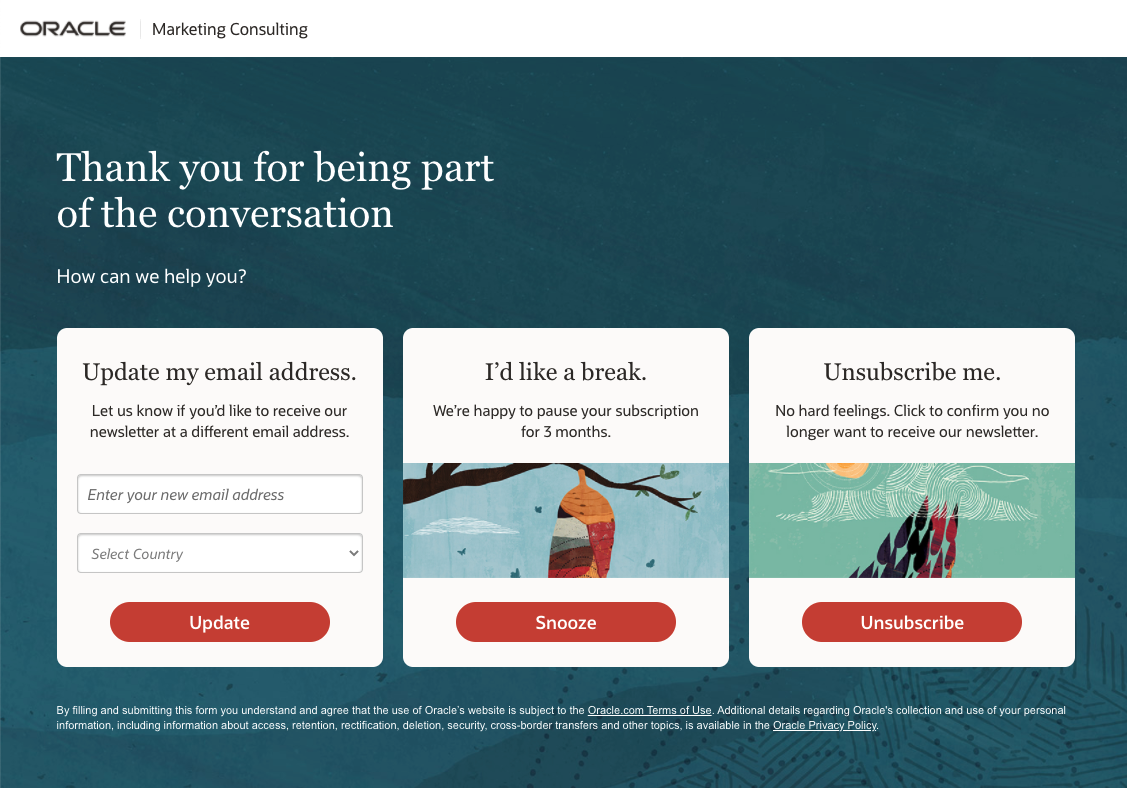The email snooze began humbly to reduce unsubscribes during brands’ highest volume times of the year. For example, this option would let a subscriber pause their subscription for 30 days or until the end of a selling season, like the holidays.
However, the email snooze has since evolved from a purely seasonal role-player to a year-round driver to reduce opt-outs and increase engagement.
Let’s talk about both ways that email marketing professionals are evolving their use of the snooze.
Year-Round Preference Center Option
Adding a snooze option to your preference center is an effective retention tactic. We’ve tested the snooze option with several of our clients and are typically able to decrease unsubscribes by 82%. That level of success has caused some of our clients who implemented them solely for the holiday season to decide to make it a year-round option on their unsubscribe page or in their preference center.
This shift is driven by the recognition that it’s not just email frequency or a disinterest in seasonal messaging that would make someone want to pause their messages from a brand. Other reasons might include:
- Taking time off from work
- Unemployment or experiencing financial hardship
- Working out of the state or country for an extended period
These are just some of the reasons subscribers may pause a subscription in the preference center for our Oracle Digital Experience Agency newsletter. We allow them to snooze their subscription for up to three months, or six newsletters, since we send twice a month.
Snooze duration
A three-month pause is the longest we’d recommend because the longer you pause, the greater the risk of the reader forgetting that they subscribed and reporting your email as spam.
While two or three months is a good snooze duration for most B2B brands, B2C brands and other high-frequency senders should consider a shorter pause of one month. We recommend keeping it simple by only providing one snooze duration option. But, you could do some testing to determine the most effective duration for your audience.
Snooze reminders
Another way to reduce the risk of surprising your subscribers when emails resume after a pause is to include a banner at the top of your first email or two that acknowledges the snooze. It’s like the permission reminder that some brands include in their footers reminding subscribers where and when they subscribed or why they’re receiving a particular triggered email. However, this banner should ideally be less formal and more empathetic than your typical permission reminder since it’s so prominent.
Going from a seasonal option to a year-round option in your preference center is just one of the ways that marketers have been expanding their use of the email snooze. Now let’s dive into the newest evolution.
The Option to Snooze Specific Email Marketing Campaigns
While adding a snooze option to your unsubscribe page or preference center significantly lowers the risk of unsubscribes, the opt-out risk is still there. That’s why some brands have started promoting the snooze option going into selling seasons where the messaging might not be ideal for everyone.
For example, we worked with a luxury fashion retail brand to include messaging in their email marketing that gave subscribers the option to snooze the brand’s Mother’s Day campaigns. The move, which took only a little effort to implement, was made out of respect for subscribers who have lost their mothers, which can make Mother’s Day a particularly painful holiday. The pandemic only heightened this concern.
Ultimately, about 1% of subscribers chose to snooze the brand’s Mother’s Day campaigns, a part of their base that was already unlikely to respond to these campaigns and might have even considered unsubscribing to avoid seeing them. Instead, that 1% likely felt seen, which should translate into longer time on list, higher subscriber lifetime values, and increased goodwill. Our client was so pleased with their results that they plan to offer a similar snooze option for their Father’s Day campaigns and several others.
Potentially snooze-worthy events
Here are a few events you may want to include when considering snooze options for your campaigns:
- Valentine’s Day and wedding season
- Back to school, which can be sensitive for those who have lost a child or are struggling with infertility
- Holiday season, where the snooze option can help you avoid those who have finished their gift shopping or don’t celebrate
- Summer and winter season merchandise
For occasions like Mother’s Day, Father’s Day, Valentine’s Day, wedding season, and back to school, we recommend allowing subscribers to snooze these campaigns right from the start by including that offer in the first message of the campaign.
For longer occasions like the holiday, summer, and winter seasons, consider adding a snooze option at the halfway point in your campaign. For the holiday season, for example, that might be at the end of the week of Cyber Monday, or right after Green Monday.
There’s certainly no reason that you can’t extend this strategy to smaller occasions, too. For instance, I wasn’t interested in receiving “New Year, New You” messaging this year, considering how much I had to adjust during 2020, but I know a lot of people were excited to kick off 2021 with a fresh start. If given the option, I would have opted out. Instead, I would have reacted more favorably to some new arrivals or holiday bestseller messaging.
In the end, using the snooze option in this way is really about two things:
1. Empathy
This 2020 buzzword came in the wake of the coronavirus lockdowns. While marketers always said empathy was part of their messaging equation, COVID-19 woke up marketers to the urgent need for more compassionate and subscriber-centric messaging. They’ve embraced that priority by not only changing how they communicate in their broadcast messages, but also in their triggered messages, which unfortunately are rarely updated and optimized.
With this top of mind, we’re seeing brands use the email snooze as a tool of empathy in the same way that trigger warnings have been added to TV shows. After all, why risk potentially offending and losing a subscriber when a simple disclosure and the ability to skip the content avoids the issue completely?
2. Relevance
Marketers are increasingly using RFM modeling, fatigue analysis, and other tools for segmentation targeting to maximize engagement and minimize opt-outs and inactivity. But no matter how sophisticated these tools get, sometimes the most effective approach is allowing your customers to simply tell you what they want—and what they don’t––to avoid fatigue.
With privacy laws tightening globally, we’re on a clear trajectory of more customer empowerment. Along with preference centers and progressive profiling, the email snooze has a role to play in collecting vital subscriber feedback. That gives subscribers more control and makes them more active players in the messaging they’re receiving, which is a positive for profitable long-term customer relationships.
—————
Need help with your email marketing program? Oracle Digital Experience Agency has hundreds of marketing and communication experts ready to help Responsys, Eloqua, Unity, and other Oracle customers create stronger connections with their customers and employees—even if they’re not using an Oracle platform as the foundation of that experience. With a 94% satisfaction rate, our clients are thrilled with the award-winning work our creative, strategy, and other specialists do for them, giving us an outstanding NPS of 82.
For help overcoming your challenges or seizing your opportunities, talk to your Oracle account manager, visit us online, or email us at OracleAgency_US@Oracle.com.
To stay up to date on customer experience best practices and news, subscribe to Oracle Digital Experience Agency’s award-winning, twice-monthly newsletter. View archive and subscribe →

